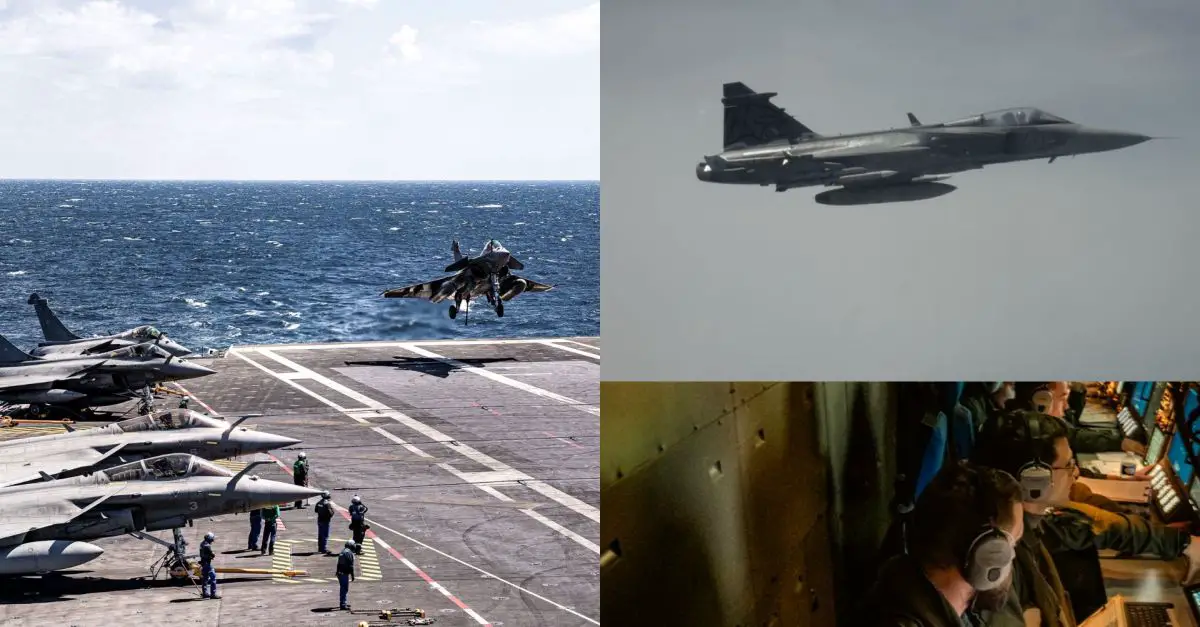Breaking news
French fighter Rafale performs 4,000 km strike India seems interested in long range strike capacity.
NATO launched one of its largest naval deployments since Russia's invasion of Ukraine last month, called Neptune Strike (NEST), with the French aircraft carrier Charles de Gaulle participating in military exercises under NATO command for the first time. The French aircraft carrier and its accompanying ships were the centerpiece of maritime strike exercises aimed at enhancing integration and interoperability among NATO states.
Follow Army Recognition on Google News at this link

Left: Rafale landing on Charles de Gaulle carrier, top right: Rafale-M in flight during Neptune Strike, bottom right : inside of an Atlantic 2, surveillance aircraft (Picture source: X/NATOcommand)
The French aircraft carrier was deployed in the Mediterranean, near its home port of Toulon. Although precise details were not available for security reasons, Rear Admiral Jacques Mallard, commander of the French CSG, showed a slide of the Charles De Gaulle carrying an embarked air squadron of 18 Rafale M fighters, a land-based Atlantique 2 maritime patrol aircraft, two E-2C Hawkeye Airborne Early Warning and Control (AWEC) aircraft, and two Dauphin helicopters.
NATO described Neptune Strike (NEST) as a multi-domain and multinational enhanced vigilance activity. This impromptu maritime exercise honed NATO’s ability to integrate maritime capabilities, including carrier strike groups, to support allied defense. This made the maritime strike conducted by the Rafale-M fighters all the more significant and remarkable. The mission may have contributed to the already rising popularity of the Rafale aircraft.
The Rafale M is a single-seat multirole aircraft designed for numerous missions. It is capable of quick reaction alerts, air defense, air policing, nuclear deterrence, power projection, external missions, deep strike operations, air support for ground forces, and pilot training sorties.
On its official website, the manufacturer Dassault Aviation notes that the Rafale “meets the requirement to perform the widest range of missions with the smallest number of aircraft.” The service ceiling, or the maximum altitude it can reach under standard air conditions, is 50,000 feet. The Rafale M can conduct both air-to-ground and air-to-air attacks in a single mission, with a speed range from less than 120 knots (222.24 km/h) on approach to a maximum speed of 750 knots (1,389 mph).
With adequate refueling, the aircraft has demonstrated its capability to conduct long-range strikes from anywhere at sea. This capability could also interest India, which is looking to acquire 26 Rafale Marine fighter jets from France.
The Rafale Marines will strengthen Indian maritime capabilities.
India has officially informed France of its intention to purchase 26 Rafale fighter jets for the Indian Navy, thereby initiating the intergovernmental acquisition procedure. However, the two parties have not yet signed an official agreement. If this deal goes through, France would have sold 62 Rafale jets to India, including 36 to the Indian Air Force (IAF).
The order for the naval variant of the Rafale could be placed later this year to meet the urgent operational needs of the Indian Navy. The Indian Navy had previously informed the Indian Ministry of Defense of its preference for the French Rafale Marine fighter over its sole competitor, Boeing’s F/A-18 Super Hornet.
The Indian Naval Air Arm is seeking a replacement for its aging MiG-29K aircraft, the combat aircraft platform of the Russian-origin INS Vikramaditya, the other operational aircraft carrier. The Rafale-M aircraft will be used aboard the locally developed aircraft carrier INS Vikrant.
The first locally built aircraft carrier by the Indian Navy, INS Vikrant, entered service in September 2022. However, critical aeronautical tests of the onboard conventional fighter MiG-29K and the home-based Naval LCA began several months ahead of schedule.
India is developing its own twin-engine deck-based fighter (TEDBF) to meet its long-term needs for carrier-based missions. However, the Indian Navy has decided to purchase a new carrier-based combat aircraft to meet its short-term needs, as it will take some time for the country's naval combat aircraft to be developed domestically.
When India and France sign an agreement for the purchase of the Rafale Marine, the Indian Navy will become the first export customer for this carrier-based fighter. Paris has already successfully exported the Air Force variant to several countries, including India.
The recent achievement accomplished by the jet during NATO maritime exercises bodes well for the French aircraft's reputation, especially as the country seeks to further boost its exports.


























